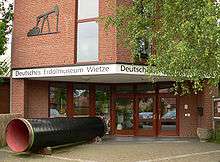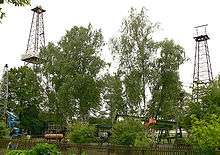German Oil Museum
The German Oil Museum (German: Deutsches Erdölmuseum Wietze) is located in Wietze, a small village west of Celle in Lower Saxony.


Description
The exhibitions in the museum's buildings use a combination of text, diagrams and models to describe the origin, occurrence, prospecting, extraction, processing and uses of crude oil. In addition, the history of crude oil extraction and use, particularly in the region around Wietze, is vividly portrayed. On a site of about 2 hectares (4.9 acres) in size, old and modern technical installations used for extraction, prospecting and refining crude oil are exhibited. Occasionally there are mining shows at which objects associated with mining, minerals and fossils may be swapped, bought or sold.
Wietze and crude oil
The village of Wietze has played a special role in the history of crude oil extraction. As early as the 17th century, crude oil from mineral deposits at Wietze was scooped from tar pits on the surface and used as a grease and medicament. In 1858 one of the first boreholes in the world for the extraction of oil was sunk here. From 1920 to 1963 oil was also extracted from underground mines.
 Oil from Wietze
Oil from Wietze Oil barrels from different eras
Oil barrels from different eras Blowout preventer on an oil drilling tower
Blowout preventer on an oil drilling tower Drilling bit
Drilling bit
See also
- List of petroleum museums